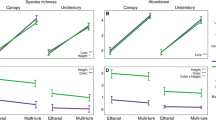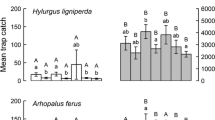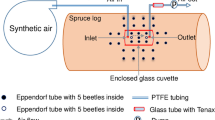Abstract
Exotic bark and wood-boring beetles [Buprestidae, Cerambycidae, Curculionidae (Scolytinae)] are among the most damaging forest pests, and species of quarantine significance are frequently moved intercontinentally. Early detection of these potentially invasive species is critical for their effective management, and while current surveillance methods have intercepted many species, they failed to detect others that subsequently became significant pests. We evaluated the effects of trap height (canopy vs. understory) and lure type (host volatiles vs. blends of host volatiles and pheromones) on the efficacy of detecting bark and wood-boring beetles, with the objective of improving surveillance programs. Adding pheromones to host volatile-baited traps increased the number of species detected, but lure performance (mean catch and detection rate) varied among species. The effects of trap height also varied by taxa; some species were detected more often in the understory (e.g., Scolytinae), and others mainly in the canopy (e.g., Cerambycidae). Species assemblages in traps differed between the canopy and understory and also among lure types. The number of target species detected was increased by using combinations of different pheromone-enhanced lure blends and by placing traps in both the canopy and understory. Applying these results should improve early detection of exotic species commonly moved intercontinentally in wood packaging and products.





Similar content being viewed by others
References
Allison JD, Redak RA (2017) The impact of trap type and design features on survey and detection of bark and woodboring beetles their associates: a review and meta-analysis. Annu Rev Entomol 62:127–146
Allison JD, Borden JH, Seybold SJ (2004) A review of the chemical ecology of the Cerambycidae (Coleoptera). Chemoecology 14:123–150
Allison JD, McKenney JL, Millar JG, McElfresh S, Mitchell RF, Hanks LM (2012) Response of the woodborers Moochamus carolinensis and Monochamus titillator (Coleoptera: Cerambycidae) to known cerambycid pheromones in the presence and absence of the host plant volatile α-pinene. Environ Entomol 41:1587–1596
Allison JD, McKenney JL, Miller DR, Gimmel ML (2013) Kairomonal responses of natural enemies and associates of the southern Ips (Coleoptera: Curculionidae: Scolytinae) to Ipsdienol, Ipsenol and cis-verbenol. J Insect Behav 26:321–335
Aukema JE, McCullough DG, Von Holle B, Liebhold AM, Britton K, Frankel SJ (2010) Historical accumulation of nonindigenous forest pests in the continental United States. Bioscience 60:886–897
Aukema JE, Leung B, Kovacs K, Chivers C, Britton KO, Englin J et al (2011) Economic impacts of non-native forest insects in the continental United States. PLoS ONE 6(9):e24587. https://doi.org/10.1371/journal.pone.0024587
Bashford R (2008) The development of a port surrounds trapping system for the detection of exotic forest insect pests in Australia. In: Oteng-Amoako AA (ed) New advances and contribution to forestry research. InTech, Rijeka, pp 85–100
Bense U (1995) Illustrated key to the Cerambycidae and Vesperidae of Europe. Margraf Verlag, Weikersheim
Boone CK, Sweeney J, Silk P, Hughes C, Webster RP, Stephen F et al (2018) Monochamus species from different continents can be effectively detected with the same trapping protocol. J Pest Sci. https://doi.org/10.1007/s10340-018-0954-4
Brockerhoff EG, Jones DC, Kimberley MO, Suckling DM, Donaldson T (2006) Nationwide survey for invasive wood-boring and bark beetles (Coleoptera) using traps with pheromones and kairomones. For Ecol Manag 228:234–240
Brockerhoff EG, Liebhold AM, Richardson B, Suckling DM (2010) Eradication of invasive forest insects: concepts, methods, costs and benefits. NZ J For Sci 40(suppl):S117–S135
Canadian Food Inspection Agency (CFIA) (2009).Plant protection survey reports 2009. CFIA, Ottawa. http://publications.gc.ca/site/eng/9.831610/publication.html. Accessed 15 Aug 2017
Canadian Food Inspection Agency (CFIA) (2016) Plant protection survey report 2015–2016. CFIA, Ottawa. http://publications.gc.ca/site/eng/9.831610/publication.html. Accessed 15 Aug 2017
Cappaert D, McCullough DG, Poland TM, Siegert NW (2005) Emerald ash borer in North America: a research and regulatory challenge. Am Entomol 51:152–165
Chénier JVR, Philogène BJR (1989) Field responses of certain forest Coleoptera to conifer monoterpenes and ethanol. J Chem Ecol 15:1729–1745
Colwell RK (2013) EstimateS: Statistical estimation of species richness and shared species from samples. Version 9. User’s guide and application. http://purl.oclc.org/estimates. Accessed Jan 2018
Dodds KJ (2014) Effects of trap height on captures of arboreal insects in pine stands of northeastern United States of America. Can Entomol 146:80–89
Fonseca MG, Vidal DM, Zarbin PH (2010) Male-produced sex pheromone of the cerambycid beetle Hedypathes betulinus: chemical identification and biological activity. J Chem Ecol 36:1132–1139
Food and Agriculture Organization (FAO) Intergovernmental Panel on Climate Change (IPCC) (2013) Regulation of wood packing material in international trade. International standards for phytosanitary measures 15. International Plant Protection Convention of the FAO. https://www.ippc.int/publications/regulation-wood-packaging-materialinternational-trade-0. Accessed 15 Aug 2017
Francese JA, Fraser I, Lance DR, Mastro VC (2011) Efficacy of multifunnel traps for capturing emerald ash borer (Coleoptera: Buprestidae): effect of color, glue, and other trap coatings. J Econ Entomol 104:901–908
Gardiner L (1957) Collecting wood-boring beetle adults by turpentine and smoke. Can For Serv Bi Mon Res Note 13:2
Gotelli NJ, Colwell RK (2011) Estimating species richness. In: Magurran AE, McGill BJ (eds) Frontiers in measuring biodiversity. Oxford University Press, New York, pp 39–54
Graham EE, Poland TM, McCullough DG, Millar JG (2012) A comparison of trap type and height for capturing cerambycid beetles (Coleoptera). J Econ Entomol 105:837–846
Haack RA (2006) Exotic bark- and wood-boring Coleoptera in the United States: recent establishments and interceptions. Can J For Res 36:269–288
Haack RA, Britton KO, Brockerhoff EG, Cavey JF, Garrett LJ, Kimberley M et al (2014) Effectiveness of the International Phytosanitary Standard ISPM No. 15 on reducing wood borer infestation rates in wood packaging material entering the United States. PLoS ONE 9(5):e96611. https://doi.org/10.1371/journal.pone.0096611
Hanks LM, Millar JG (2013) Field bioassays of cerambycid pheromones reveal widespread parsimony of pheromone structures, enhancement by host plant volatiles, and antagonism by components from heterospecifics. Chemoecology 23:21–44
Hanks LM, Millar JG (2016) Sex and aggregation-sex pheromones of cerambycid beetles: basic science and practical applications. J Chem Ecol 42:631–654
Hanks LM, Millar JG, Mongold-Diers JA, Wong JCH, Meier LR, Reagel PF, Mitchell RF (2012) Using blends of cerambycid beetle pheromones and host plant volatiles to simultaneously attract a diversity of cerambycid species. Can J For Res 42:1050–1059
Hughes CC, Johns RC, Sweeney JD (2014) A technical guide to installing beetle traps in the upper crown of trees. J Acad Entomol Soc 10:12–18
Hughes GP, Meier LR, Zou Y, Millar JG, Hanks LM, Ginzel MD (2016) Stereochemistry of fuscumol and fuscumol acetate influences attraction of longhorned beetles (Coleoptera: Cerambycidae) of the subfamily Lamiinae. Environ Entomol 45:1271–1275
Ibeas F, Gallego D, Diez JJ, Pajares JA (2007) An operative kairomonal lure for managing pine sawyer beetle Monochamus galloprovincialis (Coleoptera: Cerambycidae). J Appl Entomol 131:13–20
Juutinen P (1955) Zur Biologie und forstlichen Bedeutung der Fichtenböcke (Tetropium Kirby) in Finnland. Acta Entomol Fenn 11:1–112
McCune B, Grace JB (2002) Analysis of ecological communities. MJM Software Design, Gleneden Beach
Menocal O, Kendra PE, Montgomery WS, Crane JH, Carrillo D (2018) Vertical distribution and daily flight periodicity of ambrosia beetles (Coleoptera: Curculionidae) in Florida avocado orchards affected by laurel wilt. J Econ Entomol 111:1190–1196
Meurisse N, Rassati D, Hurley BP, Brockerhoff EG, Haack RA (2018) Common pathways by which non-native forest insects move internationally and domestically. J Pest Sci. https://doi.org/10.1007/s10340-018-0990-0
Millar JG, Hanks LM (2016) Chemical ecology of cerambycid beetles. In: Wang Q (ed) Cerambycidae of the world: biology and management. CRC Press, Boca Raton
Millar JG, Richards AB, Halloran S, Zou Y, Boyd EA, Quigley KN, Hanks LM (2018) Pheromone identification by proxy: identification of aggregation-sex pheromones of North American cerambycid beetles as a strategy to identify pheromones of invasive Asian congeners. J Pest Sci. https://doi.org/10.1007/s10340-018-0962-4
Miller DR (2006) Ethanol and (–)-α-pinene: attractant kairomones for some large wood-boring beetles in southeastern USA. J Chem Ecol 32:779–794
Miller DR, Rabaglia RJ (2009) Ethanol and (–)-α-pinene: attractant kairomones for bark and ambrosia beetles in the southeastern US. J Chem Ecol 35:435–448
Miller DR, Crowe CM, Dodds KJ et al (2015a) Ipsenol, ipsdienol, ethanol, and a-pinene: trap lure blend for Cerambycidae and Buprestidae (Coleoptera) in pine forests of eastern North America. J Econ Entomol 108:1837–1851
Miller DR, Crowe CM, Mayo PD, Silk PJ, Sweeney JD (2015b) Responses of Cerambycidae and other insects to traps baited with ethanol, 2-3, hexanediol, and 3,2-hydroxyketone lures in North-Central Georgia. J Econ Entomol 108:2354–2365
Miller DR, Allison JD, Crowe CM et al (2016) Pine sawyers (Coleoptera: Cerambycidae) attracted to α-pinene, monochamol, and ipsenol in North America. J Econ Entomol 109:1205–1214
Mitchell RF, Graham EE, Wong JCH et al (2011) Fuscumol and fuscumol acetate are general attractants for many species of cerambycid beetles in the subfamily Lamiinae. Entomol Exp Appl 141:71–77
Montgomery ME, Wargo PM (1983) Ethanol and other host-derived volatiles as attractants to beetles that bore into hardwoods. J Chem Ecol 9:181–190
Nealis VG, DeMerchant I, Langor D et al (2016) Historical occurence of alien arthropods and pathogens on trees in Canada. Can J For Res 46:172–180
Payton ME, Greenstone MH, Schenket N (2003) Overlapping confidence intervals or standard error intervals: what do they mean in terms of statistical significance? J Insect Sci 3:34
Rabaglia RJ, Duerr D, Acciavatti RE, Ragenovich I (2008) Early detection and rapid response for non-native bark and ambrosia beetles. US Department of Agriculture Forest Service, Forest Health Protection, Washington, p 12
Rassati D, Petrucco Toffolo E, Roques A, Battisti A, Faccoli M (2015) Trapping wood boring beetles in Italian ports: a pilot study. J Pest Sci 87:61–69
Rassati D, Marini L, Marchioro M, Rapuzzi P, Magnani G, Poloni R, Di Giovanni F, Mayo P, Sweeney J (2018) Developing trapping protocols for wood-boring beetles associated with broadleaf trees. J Pest Sci. https://doi.org/10.1007/s10340-018-0984-y
Ryall K, Silk P, Webster RP et al (2015) Further evidence that monochamol is attractive to Monochamus (Coleoptera: Cerambycidae) species, with attraction synergized by host plant volatiles and bark beetle (Coleoptera: Curculionidae) pheromones. Can Entomol 147:564–579
Schmeelk TC, Millar JG, Hanks LM (2016) Influence of trap height and bait type on abundance and species diversity of cerambycid beetles captured in forests of east-central Illinois. J Econ Entomol 109:1750–1757
Schroeder LM, Lindelöw A (1989) Attraction of scolytids and associated beetles by different absolute amounts and proportions of α-pinene and ethanol. J Chem Ecol 15:807–817
Silk PJ, Sweeney J, Wu J, Price J, Gutowski JM, Kettela EG (2007) Evidence for a male-produced pheromone in Tetropium fuscum (F.) and Tetropium cinnamopterum (Kirby) (Coleoptera: Cerambycidae). Naturwissenschaften 94:697–701
Skvarla MJ, Dowling AP (2017) A comparison of trapping techniques (Coleoptera: Carabidae, Buprestidae, Cerambycidae, and Curculionoidea excluding Scolytinae). J Insect Sci 17:1–28
Sweeney JD, Silk PJ, Gutowski JM et al (2010) Effect of chirality, release rate, and ost volatiles on response of Tetropium fuscum (F.), Tetropium cinnamopterum Kirby, and Tetropium castaneum (L.) to the aggregation perromone, fuscumol. J Chem Ecol 36:1309–1321
Sweeney JD, Silk PJ, Grebennikov V (2014) Efficacy of semiochemicals-baited traps for detection of longhorn beetles (Coleoptera: Cerambycidae) in the Russian Far East. Eur J Entomol 111:397–406
Sweeney JD, Silk PJ, Grebennikov V, Mandelshtam M (2016) Efficacy of semiochemicals-baited traps for detection of Scolytinae species (Coleoptera: Curculionidae) in the Russian Far East. Eur J Entomol 113:84–97
Ulyshen MD, Hanula JL (2007) A comparison of the beetle (Coleoptera) fauna captured at two heights above the ground in a North American temperate deciduous forest. Am Mid Nat 158:260–278
Ulyshen MD, Sheehan TN (2017) Trap height considerations for detecting two economically important forest beetle guilds in southeastern US forests. J Pest Sci. https://doi.org/10.1007/s10340-017-0883-7
Vance CC, Kirby KR, Malcolm JR, Smith SM (2003) Community composition of longhorned beetles (Coleoptera: Cerambycidae) in the canopy and understorey of sugar maple and white pine stands in south-central Ontario. Environ Entomol 32:1066–1074
Wermelinger B, Flückiger PF, Obrist MK, Duelli P (2007) Horizontal and vertical distribution of saproxylic beetles (Col., Buprestidae, Cerambycidae, Scolytinae) across sections of forest edges. J Appl Entomol 131:104–114
Wickham JD, Lu W, Zhang LW, Chen Y, Zou Y, Hanks LM, Millar JG (2016) Likely aggregation-sex pheromones of the invasive beetle Callidiellum villosulum, and the related Asian species Allotraeus asiaticus, Semanotus bifasciatus, and Xylotrechus buqueti (Coleoptera: Cerambycidae). J Econ Entomol 109:2243–2246
Wong JCH, Mitchell RF, Striman BL, Millar JG, Hanks LM (2012) Blending synthetic pheromones of cerambycid beetles to develop trap lures that simultaneously attract multiple species. J Econ Entomol 105:906–915
Wood DL (1982a) The role of pheromones, kairomones, and allomones in the host selection and colonization behavior of bark beetles. Annu Rev Entomol 27:411–446
Wood SL (1982b) The bark and ambrosia beetles of North and Central America. Gt Basin Nat Mem 6:1–1359
Wood SL, Bright DE (1992) A catalog of Scolytidae and Platypodidae (Co-leoptera), part 2: taxonomic index. Gt Basin Nat Mem 13:1–1553
Wu Y, Trepanowski NF, Molongoski JJ, Reagel PF, Lingafelter SW, Nadel H, Myers SW, Ray AM (2017) Identification of wood-boring beetles (Cerambycidae and Buprestidae) intercepted in trade associated solid wood packaging material using DNA barcoding and morphology. Sci Rep 7:40316
Yanega D (1996) Field guide to northeastern longhorned beetles (Coleoptera: Cerambycidae). Illinois natural history survey manual 6, Champaign, IL
Zou Y, Rutledge CE, Nakamuta K et al (2016) Identification of a pheromone component and a critical synergist for the invasive beetle Callidiellum rufipenne (Coleoptera: Cerambycidae). Environ Entomol 45:216–222
Acknowledgments
We thank the Canadian Food Inspection Agency Science Branch; Natural Resources Canada, Canadian Forest Service Forest Invasive Alien Species program; United States Department of Agriculture Animal and Plant Health Inspection Service—Plant Protection & Quarantine; MacEwan University; Atlantic Canada Opportunities Agency—Atlantic Innovation Fund; and the Ontario Ministry of Natural Resources and Nova Scotia Department of Natural Resources (through SERG International) for funds and in-kind support. We also thank the Canadian Department of National Defence and Alberta Transportation for field site access. We thank B Anderson, P Bouchard, D Bright, A Cognato, A Davies, H Douglas, S Laplante, and R Webster for taxonomic expertise, and C Alderson, L Flemming, J Francese, C Gomez, J Hammond, T Kimoto, JP Lafontaine, L Leachman, M Luco, C MacKay, T Nelson, K Sücko, D Tighe, V Webster, D Williams and H Young for technical or administrative support.
Author information
Authors and Affiliations
Corresponding author
Ethics declarations
Conflict of interest
All authors declare that they have no conflict of interest relevant to this study. This article does not contain any studies with human participants or animals performed by any of the authors.
Additional information
Communicated by A. Battisti.
Special Issue on Invasive Pests of Forests and Urban Trees.
Electronic supplementary material
Below is the link to the electronic supplementary material.
Rights and permissions
About this article
Cite this article
Flaherty, L., Gutowski, J.M.G., Hughes, C. et al. Pheromone-enhanced lure blends and multiple trap heights improve detection of bark and wood-boring beetles potentially moved in solid wood packaging. J Pest Sci 92, 309–325 (2019). https://doi.org/10.1007/s10340-018-1019-4
Received:
Revised:
Accepted:
Published:
Issue Date:
DOI: https://doi.org/10.1007/s10340-018-1019-4




